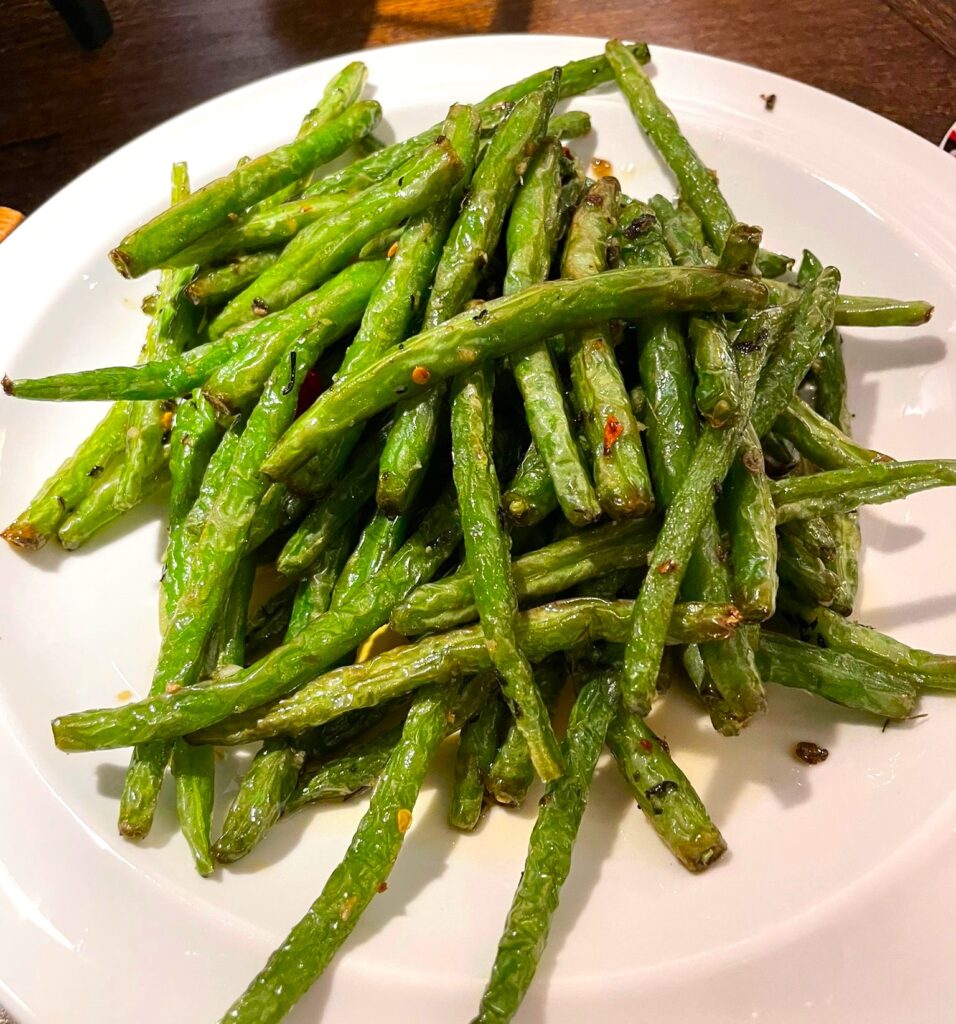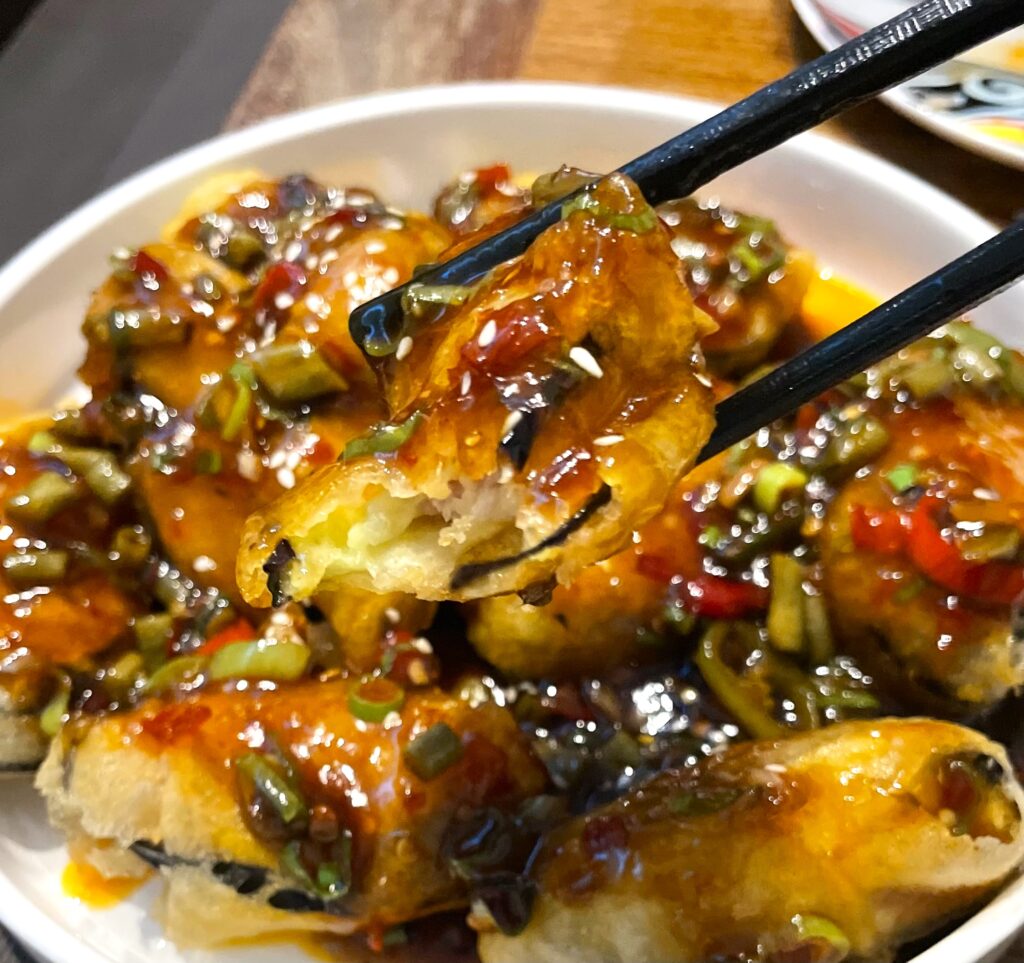In our previous posts, we may have teased your taste buds with a glimpse into the spicy world of authentic Sichuan food at Höfchen Restaurant in Frankfurt. Known as one of the flagship Sichuan restaurants in Frankfurt, this place offers a dazzling array of Sichuan dishes that go far beyond what we’ve showcased so far.
Sichuan cuisine, one of China’s four major culinary traditions, is celebrated for its bold, spicy, and numbing flavors, as well as its impressive array of cooking techniques. It typically uses wild and foraged ingredients from the mountains, fresh seafood, and vibrant vegetables, all seasoned with the likes of Sichuan peppercorns, chilies, fermented bean paste (or 豆瓣酱), and fermented tofu (or 腐乳). With over 40 cooking methods, from sizzling stir-fries to oil-soaked crispy fries, the flavors are anything but ordinary.
Today, we’re diving back into this thrilling and mouth-watering world, ready to embark on a sequel of taste adventure that’s both exotic and irresistibly delicious!
Restaurant Profile
- Name of the Restaurant: Höfchen Chinese Restaurant (incl. Menu)
- Adress: Kaiserhofstraße 18-20, 60313 Frankfurt am Main
- Style: Chinese Sichuan Cuisine
- Price: around 25 – 35 EUR per Person (incl. drinks and tips)
Mao Cai (冒菜 or Chengdu Fondue) is a beloved dish originating from Sichuan with a rich history dating back to the Late Han Dynasty (mid-2nd century CE to 220 CE) and the Three Kingdoms period (220 to 280 CE). By the Western Han era (206 BC to 9 AD, Sichuan cuisine had already begun to take shape, thanks to the widespread use of well salt, which fostered a local preference for bold and spicy flavors.
In the “Ode to Shu” by Western Jin poet Zuo Si, there is a mention of “调夫五味” (adjusting the five flavors), highlighting the use of medicinal herbs for seasoning. During the late Eastern Han Dynasty, constant warfare brought various illnesses to the troops, which reduced their appetite. Military doctors, to prevent disease spread and stimulate the soldiers’ appetites, instructed cooks to add medicinal herbs to their dishes. These herbs not only provided therapeutic benefits, but also enhanced the flavors. Over time, the cooks discovered that blanching various vegetables with these herb-infused broths resulted in tastier dishes that became favorites among the soldiers. This method of cooking, known as “Mao Cai,” spread throughout the military.
When these military cooks retired and returned to civilian life, they took this cooking method with them and opened “Mao Cai” restaurants, which quickly became popular and led to an era of unprecedented prosperity for Mao Cai.
Today, Mao Cai is enjoyed across China, with regional variations to suit local tastes. There are different styles, such as hot pot Mao Cai, clear broth Mao Cai, mildly spicy Mao Cai, and vine pepper Mao Cai. At Höfchen, the Mao Cai leans towards the hot pot style, essentially offering a personal hot pot experience.

The broth is prepared using dozens of harmless medicinal herbs, combined with secret seasonings and common spices like dried chilies, Sichuan peppercorns, fermented bean paste (豆瓣酱), star anise, fennel, and sugar. These ingredients are stir-fried over low heat until the oil turns red, then deglazed with cooking wine and water to create a rich, flavorful base.
Various ingredients such as potato slices, lotus root slices, cauliflower, konjac noodles, tofu, wood ear mushrooms, potato noodles, mushrooms, tripe, pork belly, luncheon meat, crab sticks, shrimp, and tender beef are added to this broth, absorbing its deep flavors. Finally, it is finished with a drizzle of red oil, salt, chopped green onions, minced garlic, and sesame oil.
Mao Cai is characterized by its spicy, numbing, and aromatic qualities that awaken the taste buds. The spicy flavor is the soul of Mao Cai, enhancing aroma, reducing greasiness, masking off-flavors, stimulating appetite, dispelling dampness, and warming the body. The ingredients themselves, whether meat or vegetables, release their natural flavors during cooking, making the dish both satisfying and appetizing. The broth, while flavorful, is generally not consumed on its own.
Mao Cai is probably one of the most representative dishes from the exotic and irresistibly delicious world of Sichuan cuisine.

Originally a signature dish from Xinjiang, Lamb Meat with Cumin (孜然羊肉 or Lammfleisch mit Kreuzkümmel) has made its mark in Sichuan cuisine circles. Perhaps it’s the fiery flair of cumin perfectly matching the zest of Sichuan flavors that has made it a hit among Sichuan cuisine lovers.

Cumin boasts a unique oily richness and a strong fragrance that adds depth to dishes. Its earthy, warm, and spicy aroma not only masks the gaminess of lamb, but also highlights its natural clean, slightly sweet freshness, creating a perfect balance. This paring has thus become one of the best ways to prepare lamb in the region.
Made from succulent lamb shank, cooked with fresh cilantro leaves and an array of spices, Höfchen’s method brings out the natural succulence of the lamb. Each bite evokes the sensation of savoring grilled skewers—slightly charred on the outside, yet juicy and plump on the inside. Covered in rich cumin and chili, every mouthful bursts with flavorful tenderness and enticing aroma that’s almost addictive!
Pork Belly in Chili Garlic Sauce (Schweinbauch in Chili-Knoblauch Sauce or 蒜泥白肉) is a classic Sichuan dish. It features boiled, thinly sliced pork belly, ensembled with crisp cucumber slices, all dressed in a flavorful mix of soy sauce, chili oil, vinegar, sesame oil, a touch of sugar, and a fresh, fragrant garlic paste.

As soon as the dish arrives, the tantalizing aroma of Mala (numbing) spice and fresh garlic hits you head-on. The pork belly itself is very succulent and juicy. Boiled in clear water with skin on, it takes on a rich and glossy appearance. Cut evenly, each slice curves delicately after cooking. Thanks to the fine balance of lean and fat, the meat has a tender, non-greasy texture.
The sauce beautifully enhances the natural richness of the pork belly, delivering a mouthwatering blend of spicy, tangy, and garlicky flavors, finished with a hint of sweetness. Pair the soft, juicy pork with fresh, crunchy cucumbers to keep the dish light, refreshing, and utterly indulgent.

Sichuan-Style Sauerkraut with Steamed Lotus-Leaf Buns (Sauerkraut nach Sichuan-Art mit Dampfnudeln in Lotusblatt-Form or 芽菜鸭米荷叶夹) features tender, flavorful duck meat combined with pickled mustard greens (芽菜) and served with soft, steamed buns shaped like lotus leaves.

This dish is known for its harmonious blend of flavors and textures. The small, chopped pieces of duck meat are tender and juicy, infused with the sour savoriness of the region’s famous pickled mustard greens. Each bite bursts with tangy, umami-rich, deep flavors, perfectly complemented by the subtle heat of chili peppers and the aromatic note of shallots.
Accompanying this flavorful mix are the steamed lotus leaf buns (荷叶饼). These fermented buns, often referred to as the “universal bun”, are soft, pillowy, and incredibly versatile. Their mild texture makes them the perfect vessel for all kinds of savory fillings. Simply tuck the savory duck and tangy pickled mustard greens mixture into the buns, and take a generous bite that’s soothing, flavorful, and fully satisfying.
水煮牛肉 (Water-Cooked Beef in Chili Oil or Rindfleisch in Chiliöl) is an iconic Sichuan dish that embodies the essence of Sichuan’s fiery flavors. At first glance, this dish may seem intimidating, as it’s abundantly adorned with dry chili peppers, earning it a reputation as one of the spiciest in Sichuan cuisine. Beneath the sea of chili lies the tender, flavorful beef and crisp veggies like bean sprouts.

Looking rich and luscious, each slice is covered with chili oil that glistens invitingly. It doesn’t taste greasy, but delicately oily and very appetizing. Not fried, but gently poached, the beef remains tender and juicy with a smooth and silky texture. Enhanced by the generous use of dry chilies and Sichuan peppercorns, the beef boasts a robust, spicy flavor that elevates its natural hearty richness. The intense aroma and fiery sensation evoke the spirit of Sichuan hotpot, while the bean sprouts offer a refreshing crunch that helps balance the heat.
干煸四季豆 (Dry-Fried Green Beans or Gebratene Grüne Bohnen) is a flavor-packed Sichuan classic. The green beans themselves offer a slightly sweet and fresh taste, with a juicy interior encased in a crisp, slightly chewy exterior. Being deep-fried, each bean segment has a mild, smoky flavor and a distinctive wrinkled appearance.

The seasoning of minced garlic, ginger, and Sichuan peppercorns imparts an aromatic and slightly numbing spiciness, characteristic of Sichuan cuisine. The dried chili peppers lend a fiery kick, while soy sauce and a touch of sugar balance the heat with savory, subtly sweet undertones.
While usually prepared with minced meat for added umami richness, you can easily ask for a vegetarian version from the kitchen. Even without meat, the spices and seasonings ensure the dish remains robust and satisfying.
鱼香茄盒 (Auberginetasche Gefüllt mit Schweinehackfleisch in Süß-Saurer Soße or Eggplant Pocket filled with Minced Pork in Sweet and Sour Sauce) is a renowned delicacy in Sichuan cuisine.


At the heart of this dish are soft eggplants, bursting with juicy freshness, sandwiching minced pork fillings. They’re wrapped in a thin, translucent batter made from egg whites, and then deep-fried until the outside turns into a golden crust.
It’s not a fish dish, but it has the taste of a simmering fish. This iconic 鱼香 (fish fragrant) flavor is achieved by weaving together the tang of pickled peppers, the subtle heat of ginger, and the sourness of vinegar.
Seasoned with shallots, chili peppers, and red pickled peppers, each mouthful is an appetizing blend of pickled sourness, subtle sweetness, and a hint of garlic and spice that is sure to awaken the senses. Sink your teeth into the crip eggplant pocket and you’ll reach the savory, umami goodness of the juicy pork. Crafted from carefully selected lean and fatty cuts, the fillings are moist and incredibly rich in flavors!
Bingfen (or 冰粉) is a Chinese dessert loved by many locals.
While we’ve covered bingfen in our previous posts, the bingfen served at Höfchen deserves a special mention. Unlike in China, the bingfen here has a slightly thicker jelly consistency that provides a more solid mouthfeel. Served cold and decorated with various toppings like sesame seeds, date pieces, goji berries (枸杞), and hawthorn (山楂), each spoonful delivers vibrant, refreshing flavors – tangy sweetness, bright tartness, slight nuttiness, and chewiness from the dry dates. It’s a perfect treat for cooling down after a fiery Sichuan feast or simply on a hot summer day.

Sichuan cuisine is said to have “a hundred flavors and a hundred dishes.” It brings together irresistible tastes like numbing spice, peppery heat, and fish fragrant flavors. Today, we’ve delved into some of the iconic dishes to experience their charm. But our journey doesn’t end here; we’re eager to dig deeper and uncover more authentic flavors cherished in local households or in mountain villages and fields. If you’re intrigued, stay tuned for more posts featuring diverse, adventurous, spicy, and tantalizing dishes.




